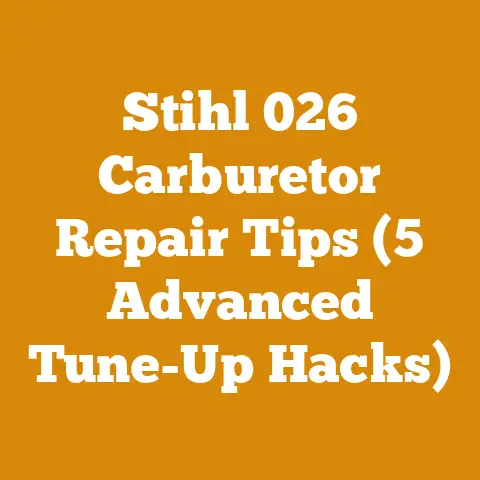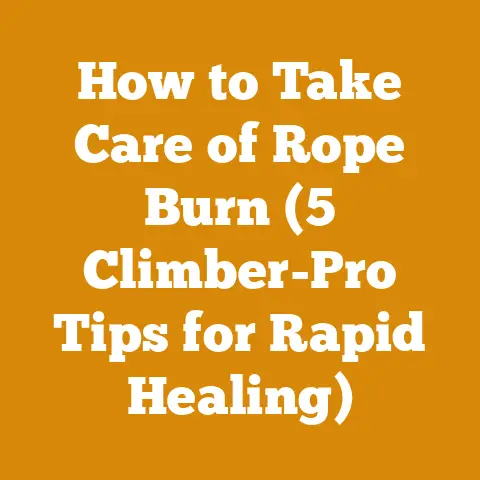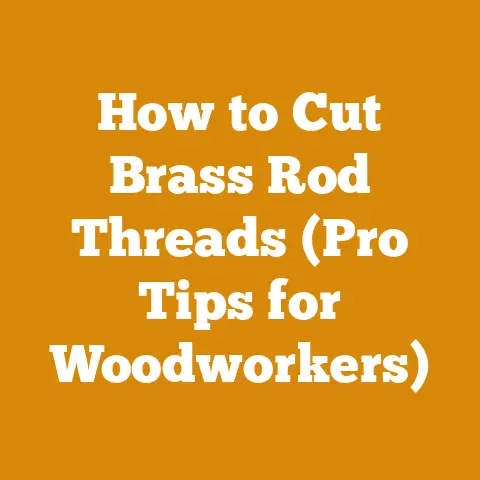Heavy Duty Trimmer Line for Wood Clearing (7 Pro Tips)
Let’s dive into the world of heavy-duty trimmer lines for wood clearing.
Introduction: Comfort is Key
I can still feel the sting in my hands, the dull ache in my shoulders. That was back in my early days, wrestling with overgrown brush using a flimsy trimmer line that snapped more often than it cut. I learned a valuable lesson then: comfort and efficiency go hand in hand. Using the right equipment, especially a robust trimmer line, isn’t just about getting the job done; it’s about preserving your body and your sanity.
In this article, I’ll share my hard-earned insights on selecting and using heavy-duty trimmer lines for wood clearing. We’ll cover everything from understanding different line shapes and materials to mastering advanced techniques that will boost your productivity and keep you safe. Whether you’re a seasoned professional or a weekend warrior, these pro tips will help you tackle even the toughest clearing jobs with confidence.
Key Takeaways:
- Choosing the Right Line: Learn how to select the optimal trimmer line based on its shape, material, and the type of vegetation you’re clearing.
- Understanding Line Shapes: Discover the pros and cons of round, square, star, and twisted trimmer lines.
- Material Matters: Compare the durability and performance of different trimmer line materials, including nylon copolymers and reinforced composites.
- Optimizing Trimmer Performance: Adjust your trimmer settings and techniques to maximize cutting power and minimize line breakage.
- Safety First: Implement essential safety measures to protect yourself from flying debris and other hazards.
- Maintenance and Storage: Extend the life of your trimmer line and equipment with proper maintenance and storage practices.
- Advanced Techniques: Master advanced cutting techniques for clearing dense brush, saplings, and other challenging vegetation.
Understanding the Need for Heavy-Duty Trimmer Line
For years, I struggled with standard trimmer lines that would constantly break when faced with anything tougher than grass. My property, a mix of dense woodland and overgrown fields, demanded something more robust. That’s when I discovered the world of heavy-duty trimmer lines designed specifically for wood clearing.
The Limitations of Standard Trimmer Line
Standard trimmer lines, typically made of basic nylon, are great for edging lawns and trimming light vegetation. However, they quickly become inadequate when dealing with thicker brush, saplings, or woody weeds. The constant breakage not only slows down your work but also becomes incredibly frustrating.
Why Heavy-Duty Lines are Essential
Heavy-duty trimmer lines are engineered to withstand the rigors of wood clearing. They are made from tougher materials, often reinforced with additives that enhance their durability and cutting power. These lines are designed to resist fraying, breaking, and melting, allowing you to tackle challenging vegetation with greater efficiency and confidence.
Tip #1: Choosing the Right Trimmer Line Shape
The shape of your trimmer line can significantly impact its cutting performance and durability. Over the years, I’ve experimented with various shapes and found that each has its strengths and weaknesses.
Round Trimmer Line
- Pros: Round lines are the most common and affordable type. They are relatively quiet and produce a clean, even cut on grass.
- Cons: Round lines lack the aggressive cutting power needed for thicker vegetation. They tend to wear down quickly when used on woody material.
- Best For: Light trimming and edging around lawns and gardens.
Square Trimmer Line
- Pros: Square lines have sharp edges that provide more aggressive cutting power than round lines. They are effective for clearing weeds and light brush.
- Cons: Square lines can be noisier than round lines and may vibrate more. They are also more prone to breakage when used on very thick vegetation.
- Best For: Medium-duty clearing of weeds, grass, and light brush.
Star-Shaped Trimmer Line
- Pros: Star-shaped lines, also known as multi-sided lines, offer a good balance of cutting power and durability. The multiple edges provide efficient cutting, while the thicker profile resists breakage.
- Cons: Star-shaped lines can be more expensive than round or square lines. They may also produce more vibration and noise.
- Best For: Versatile clearing of grass, weeds, and medium-density brush.
Twisted Trimmer Line
- Pros: Twisted lines are designed to reduce noise and vibration while maintaining excellent cutting power. The twisted shape creates a slicing action that is effective for clearing tough vegetation.
- Cons: Twisted lines can be more expensive than other types. They may also be more prone to tangling if not properly stored.
- Best For: Heavy-duty clearing of dense brush, weeds, and saplings, especially in noise-sensitive areas.
My Personal Recommendation:
For most wood clearing tasks, I prefer using a star-shaped or twisted trimmer line. These shapes provide the best combination of cutting power, durability, and noise reduction. I’ve found that they can handle a wide range of vegetation, from thick grass to small saplings, without excessive breakage.
Tip #2: Understanding Trimmer Line Materials
The material composition of your trimmer line plays a crucial role in its overall performance. Different materials offer varying degrees of strength, flexibility, and resistance to wear and tear.
Nylon Copolymer
- Description: Nylon copolymer is the most common material used in trimmer lines. It is a blend of different types of nylon that are designed to enhance strength and flexibility.
- Pros: Nylon copolymer lines are relatively inexpensive and offer a good balance of performance and durability.
- Cons: Nylon copolymer lines can be prone to melting and breaking when subjected to high heat or friction.
- Best For: General-purpose trimming and clearing of light to medium vegetation.
Reinforced Composite
- Description: Reinforced composite trimmer lines are made from nylon copolymer that is reinforced with additives such as aluminum particles or aramid fibers (like Kevlar).
- Pros: Reinforced composite lines offer superior strength, durability, and heat resistance compared to standard nylon copolymer lines.
- Cons: Reinforced composite lines are more expensive than nylon copolymer lines. They may also be more abrasive and can wear down trimmer heads more quickly.
- Best For: Heavy-duty clearing of dense brush, saplings, and woody vegetation.
My Personal Recommendation:
If you’re serious about wood clearing, invest in a reinforced composite trimmer line. The added strength and durability are well worth the extra cost, especially if you’re dealing with tough vegetation or working in hot conditions. I’ve used lines reinforced with aluminum particles and aramid fibers, and both have significantly outperformed standard nylon lines in terms of longevity and cutting power.
Tip #3: Matching Line Diameter to Your Trimmer
Using the correct line diameter is essential for optimal trimmer performance and safety. The diameter of your trimmer line should be compatible with your trimmer’s engine size and head design.
Small Electric Trimmers
- Recommended Line Diameter: 0.065″ – 0.080″
- Reasoning: Small electric trimmers typically have lower power output and are designed for light-duty trimming. Using a thicker line can overload the motor and reduce cutting efficiency.
Medium-Sized Gas Trimmers
- Recommended Line Diameter: 0.080″ – 0.095″
- Reasoning: Medium-sized gas trimmers offer a good balance of power and maneuverability. A line diameter in this range provides adequate cutting power for most trimming and clearing tasks.
Large Gas Trimmers
- Recommended Line Diameter: 0.095″ – 0.130″
- Reasoning: Large gas trimmers are designed for heavy-duty use and can handle thicker, more durable lines. Using a larger diameter line maximizes cutting power and reduces the risk of breakage when clearing dense vegetation.
Checking Your Trimmer’s Manual:
Always consult your trimmer’s manual for the manufacturer’s recommended line diameter. Using a line that is too thick can damage the trimmer head or motor, while using a line that is too thin can reduce cutting efficiency and increase the risk of breakage.
My Personal Experience:
I once tried using a 0.130″ line in a trimmer that was only rated for 0.095″. The trimmer struggled to maintain RPMs, and the head eventually cracked. Lesson learned: always follow the manufacturer’s recommendations!
Tip #4: Optimizing Trimmer Head Performance
The trimmer head is the component that holds and dispenses the trimmer line. Choosing the right type of head and maintaining it properly can significantly improve your trimmer’s performance.
Bump-Feed Heads
- Description: Bump-feed heads allow you to advance the trimmer line by tapping the head on the ground while the trimmer is running.
- Pros: Bump-feed heads are convenient and easy to use. They are ideal for general-purpose trimming and clearing.
- Cons: Bump-feed heads can be prone to jamming or malfunctioning if not properly maintained. They may also waste line if you advance too much at once.
Automatic-Feed Heads
- Description: Automatic-feed heads automatically advance the trimmer line at predetermined intervals.
- Pros: Automatic-feed heads eliminate the need to manually bump the head, which can save time and effort.
- Cons: Automatic-feed heads can be more expensive than bump-feed heads. They may also be less reliable and can waste line if the automatic advance mechanism malfunctions.
Fixed-Line Heads
- Description: Fixed-line heads use pre-cut lengths of trimmer line that are inserted into the head.
- Pros: Fixed-line heads are simple, durable, and easy to maintain. They are ideal for heavy-duty clearing tasks where you need maximum cutting power and minimal line breakage.
- Cons: Fixed-line heads require you to manually replace the line when it wears down or breaks, which can be time-consuming.
Maintaining Your Trimmer Head:
- Clean the head regularly: Remove any debris, grass, or dirt that can clog the head and interfere with line advancement.
- Lubricate moving parts: Apply a small amount of lubricant to the head’s moving parts to ensure smooth operation.
- Inspect for wear and tear: Check the head for cracks, chips, or other damage. Replace the head if necessary.
My Personal Recommendation:
For heavy-duty wood clearing, I prefer using a fixed-line head. While it requires more manual effort to replace the line, the increased durability and cutting power are worth it. I’ve found that fixed-line heads are less prone to jamming or malfunctioning when dealing with thick vegetation.
Tip #5: Mastering Cutting Techniques
The way you use your trimmer can significantly impact its efficiency and the quality of your work. Mastering a few basic cutting techniques can help you clear vegetation more quickly and safely.
Sweeping Technique
- Description: The sweeping technique involves moving the trimmer head in a wide, sweeping motion across the vegetation.
- Best For: Clearing large areas of grass, weeds, and light brush.
- Technique: Hold the trimmer at a comfortable angle and move the head in a smooth, consistent arc. Overlap each pass slightly to ensure complete coverage.
Edging Technique
- Description: The edging technique involves holding the trimmer head vertically and using it to create a clean, defined edge along sidewalks, driveways, and flower beds.
- Best For: Creating a professional-looking finish around lawns and gardens.
- Technique: Hold the trimmer head perpendicular to the edge and move it slowly and steadily along the desired line.
Scything Technique
- Description: The scything technique involves using the trimmer head to cut down tall, dense vegetation in a scythe-like motion.
- Best For: Clearing fields, meadows, and overgrown areas.
- Technique: Hold the trimmer at a low angle and swing the head in a wide arc, cutting the vegetation close to the ground.
Plunge Cutting Technique
- Description: The plunge cutting technique involves using the trimmer head to cut through thick brush or small saplings by plunging the line directly into the vegetation.
- Best For: Clearing dense patches of brush, small trees, and woody weeds.
- Technique: Hold the trimmer head at a slight angle and carefully plunge the line into the vegetation. Use short, controlled bursts to avoid kickback or binding.
Cutting Direction:
Always cut away from yourself to avoid being hit by flying debris. Be mindful of your surroundings and avoid cutting towards obstacles or people.
My Personal Tip:
When clearing dense brush, start at the top and work your way down. This allows gravity to assist you and prevents the vegetation from falling back into your work area. I also find it helpful to use a combination of techniques, such as sweeping to clear large areas and plunge cutting to tackle individual saplings.
Tip #6: Prioritizing Safety
Using a trimmer can be dangerous if proper safety precautions are not followed. Always wear appropriate personal protective equipment (PPE) and be aware of your surroundings.
Essential PPE:
- Eye Protection: Wear safety glasses or a face shield to protect your eyes from flying debris.
- Hearing Protection: Wear earplugs or earmuffs to protect your ears from the loud noise of the trimmer.
- Gloves: Wear work gloves to protect your hands from blisters and cuts.
- Long Pants and Sleeves: Wear long pants and sleeves to protect your skin from scratches and abrasions.
- Sturdy Footwear: Wear work boots or sturdy shoes with good traction to prevent slips and falls.
Safe Operating Practices:
- Clear the Area: Before starting, clear the area of any obstacles, such as rocks, branches, or debris.
- Inspect the Trimmer: Check the trimmer for any damage or loose parts. Make sure the trimmer head is securely attached.
- Start the Trimmer Safely: Follow the manufacturer’s instructions for starting the trimmer. Keep your feet away from the trimmer head.
- Maintain a Safe Distance: Keep a safe distance from other people and objects while operating the trimmer.
- Avoid Overreaching: Do not overreach or extend yourself too far. Move closer to the work area as needed.
- Take Breaks: Take frequent breaks to avoid fatigue and maintain focus.
My Personal Story:
I once witnessed a coworker get hit in the leg by a piece of flying debris while using a trimmer without wearing proper PPE. He suffered a deep cut that required stitches. That incident reinforced the importance of always wearing appropriate safety gear.
Tip #7: Maintaining and Storing Your Trimmer Line
Proper maintenance and storage can significantly extend the life of your trimmer line and equipment.
Soaking Trimmer Line:
- Why: Soaking trimmer line in water can help to rehydrate it and prevent it from becoming brittle.
- How: Submerge the trimmer line in a bucket of water for 24 hours before using it.
- Frequency: Soak the line every few months, especially if you live in a dry climate.
Storing Trimmer Line:
- Keep it Cool and Dry: Store trimmer line in a cool, dry place away from direct sunlight and extreme temperatures.
- Avoid Moisture: Moisture can cause the line to deteriorate and become brittle.
- Use a Storage Container: Store the line in a sealed container to protect it from dust, dirt, and pests.
Trimmer Maintenance:
- Clean the Trimmer Regularly: Remove any debris, grass, or dirt that can accumulate on the trimmer.
- Sharpen the Blades: If your trimmer has blades, sharpen them regularly to maintain optimal cutting performance.
- Lubricate Moving Parts: Apply a small amount of lubricant to the trimmer’s moving parts to ensure smooth operation.
- Inspect for Wear and Tear: Check the trimmer for any damage or loose parts. Repair or replace any worn or damaged components.
My Personal Tip:
I always store my trimmer line in a sealed plastic container with a desiccant pack to absorb any moisture. This helps to keep the line in good condition and prevents it from becoming brittle. I also make it a habit to clean and lubricate my trimmer after each use.
Real-World Case Studies
To further illustrate the effectiveness of these tips, let’s examine a few real-world case studies:
Case Study 1: Clearing an Overgrown Field
A local farmer, Mr. Johnson, was struggling to clear an overgrown field that had been neglected for several years. The field was filled with tall grass, weeds, and small saplings. He had been using a standard trimmer with a round nylon line, but it was taking him weeks to make any progress.
After switching to a heavy-duty trimmer with a star-shaped, reinforced composite line and adopting the scything technique, Mr. Johnson was able to clear the entire field in just a few days. He also reported that the heavy-duty line lasted much longer than the standard line, saving him time and money.
Case Study 2: Maintaining a Woodlot
A homeowner, Mrs. Smith, was having trouble keeping her woodlot clear of brush and invasive species. She had been using a small electric trimmer with a thin nylon line, but it was not powerful enough to cut through the thicker vegetation.
After upgrading to a gas-powered trimmer with a twisted, reinforced composite line and learning the plunge cutting technique, Mrs. Smith was able to effectively control the brush and invasive species in her woodlot. She also found that the heavier trimmer was more comfortable to use for extended periods.
Case Study 3: Firewood Preparation
A small firewood producer, Mr. Davis, was looking for a more efficient way to clear brush and small trees around his woodlot. He had been using a chainsaw for everything, but it was time-consuming and labor-intensive.
After investing in a heavy-duty trimmer with a fixed-line head and mastering the sweeping and plunge cutting techniques, Mr. Davis was able to clear the brush and small trees much more quickly and easily. He also found that the trimmer was less tiring to use than the chainsaw, allowing him to work longer hours.
The Economics of Heavy-Duty Trimmer Lines
While heavy-duty trimmer lines may cost more upfront, they can actually save you money in the long run. Here’s a breakdown of the economics:
Reduced Line Breakage:
Heavy-duty lines are designed to withstand more abuse than standard lines, which means they break less frequently. This reduces downtime and saves you the cost of replacing broken lines.
Increased Efficiency:
Heavy-duty lines cut through vegetation more quickly and easily, which increases your overall efficiency. This allows you to complete more work in less time, saving you labor costs.
Longer Lifespan:
Heavy-duty lines are made from more durable materials, which means they last longer than standard lines. This reduces the frequency of replacements and saves you money in the long run.
Reduced Equipment Wear:
Using the correct line diameter and type can help to reduce wear and tear on your trimmer. This can extend the life of your equipment and save you money on repairs and replacements.
A Simple Calculation:
Let’s say a standard trimmer line costs \$5 per spool and lasts for 10 hours of use, while a heavy-duty trimmer line costs \$10 per spool and lasts for 30 hours of use.
- Standard Line Cost per Hour: \$5 / 10 hours = \$0.50 per hour
- Heavy-Duty Line Cost per Hour: \$10 / 30 hours = \$0.33 per hour
In this example, the heavy-duty line is actually more cost-effective in the long run, even though it costs more upfront.
Addressing Common Concerns
Here are some common concerns that people have about using heavy-duty trimmer lines:
“They’re Too Expensive”
While heavy-duty lines may cost more upfront, they can actually save you money in the long run due to their increased durability and efficiency.
“They’re Too Abrasive”
Some heavy-duty lines can be more abrasive than standard lines, which can wear down trimmer heads more quickly. However, this can be mitigated by using a high-quality trimmer head and maintaining it properly.
“They’re Too Noisy”
Some heavy-duty lines, especially those with sharp edges, can be noisier than standard lines. However, there are also quieter heavy-duty lines available, such as twisted lines.
“They’re Too Difficult to Install”
Heavy-duty lines are typically no more difficult to install than standard lines. Simply follow the manufacturer’s instructions for loading the line into your trimmer head.
Actionable Conclusions and Next Steps
Now that you have a solid understanding of heavy-duty trimmer lines for wood clearing, it’s time to put these tips into practice. Here are some actionable steps you can take:
- Assess Your Needs: Determine the type of vegetation you’ll be clearing and the size of your trimmer.
- Choose the Right Line: Select a heavy-duty trimmer line with the appropriate shape, material, and diameter for your needs.
- Optimize Your Trimmer: Adjust your trimmer settings and techniques to maximize cutting power and minimize line breakage.
- Prioritize Safety: Always wear appropriate PPE and be aware of your surroundings.
- Maintain Your Equipment: Clean and lubricate your trimmer regularly to extend its life.
- Experiment and Learn: Try different techniques and line types to find what works best for you.
- Share Your Knowledge: Pass on your knowledge and experience to others.
By following these steps, you can transform your wood clearing tasks from a chore into a satisfying and productive experience.
Final Thoughts: The Right Tool for the Job
I remember the first time I truly understood the power of using the right tool for the job. I was struggling to fell a small tree with a dull axe, sweating and straining with each swing. An old-timer walked by, chuckled, and handed me a properly sharpened chainsaw. The tree was down in minutes.
Similarly, using a heavy-duty trimmer line for wood clearing is like using a chainsaw instead of a dull axe. It’s about efficiency, safety, and getting the job done right. So, invest in the right equipment, master the techniques, and enjoy the satisfaction of clearing your land with confidence and ease.






